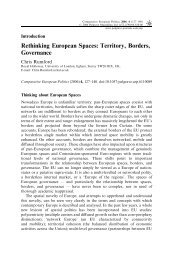Europeanisation, National Identities and Migration ... - europeanization
Europeanisation, National Identities and Migration ... - europeanization
Europeanisation, National Identities and Migration ... - europeanization
Create successful ePaper yourself
Turn your PDF publications into a flip-book with our unique Google optimized e-Paper software.
194 Norbert Cyrus<br />
which are most affected by European integration: in industries such as car<br />
production, jobs can be transferred abroad. But in construction, agriculture <strong>and</strong><br />
facility management, jobs are territorially bounded (Lubanski 1999). In these sectors<br />
the reliance on the free movement of workers <strong>and</strong> services across Europe leads<br />
to the physical presence of foreign workers in the national territory. Due to this<br />
constellation, the transformation in these sectors is a sensitive <strong>and</strong> highly politicised<br />
process (Däubler 1995). Several trends have contributed in the last two decades to<br />
a dramatic transformation process in the construction sector:<br />
1 Since the mid-1970s, the shadow economy has increased in Germany<br />
(Schneider <strong>and</strong> Ernste 2000). The growth of the shadow economy indicates that<br />
the Fordist <strong>and</strong> neo-corporatist social arrangements are breaking down. The<br />
macroeconomic orientation is replaced by an operational economic orientation<br />
that favours short-term arrangements <strong>and</strong> irregular or illegal employment.<br />
According to surveys, half of the German population have no reservations<br />
about personally participating in the shadow economy as a seller or buyer, if<br />
the opportunity arose (Lamnek et al. 2000). Today, moonlighting <strong>and</strong> illegal<br />
employment is widespread among the native population. Even if illegal<br />
employment of foreign workers contributes to the shadow economy, it is neither<br />
the cause nor the central aspect (Cyrus 2001a). In construction, the change in<br />
the production structure has facilitated the increase of illegal employment.<br />
2 Stretching back as far as the mid-1980s, the production structure in the<br />
construction industry experienced significant transformation. Huge construction<br />
enterprises proceeded to conclude contracts not with their own employees,<br />
but with subcontractors if required (cf. Cremers 1998; Hochstadt et al. 1999:<br />
124). In 1975 the ratio of subcontracting to contracts of employment in<br />
the entire German construction industry was 13 per cent, <strong>and</strong> that within the<br />
large firms was nearly 24 per cent. In 1996 it was 24 per cent for the entire<br />
industry <strong>and</strong> 41 per cent for the large firms. Meanwhile, all large firms <strong>and</strong><br />
a good number of medium <strong>and</strong> small ones simultaneously acted as general<br />
contractors or as ‘turnkey contractors’ (Syben 1998: 17). Subcontracting is<br />
a widespread option in construction, <strong>and</strong> contracts may pass through eight or<br />
more subcontractors. In the end the work is often carried out by small ‘sportshoes<br />
enterprises’ employing workers under informal or illegal conditions<br />
(Nienhüser 1999).<br />
3 During a period in which the German market attracted a growing number<br />
of foreign enterprises <strong>and</strong> workers, employers reckoned that the presence of<br />
foreign enterprises operating with lower costs would make it possible to lower<br />
German st<strong>and</strong>ards: ‘A number of firms cancelled their membership of the<br />
employers’ association, while regional associations withdrew from the national<br />
organisations, in both cases with a view to avoiding commitments to the<br />
st<strong>and</strong>ards laid down in the collective agreements’ (Lubanski 1999: 285; see also<br />
Treichler 1998: 230ff).<br />
4 After the collapse of the GDR <strong>and</strong> the re-unification, the domestic supply of<br />
construction workers increased significantly. Due to the lower productivity in



